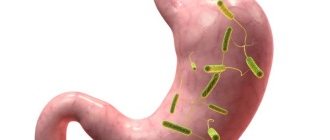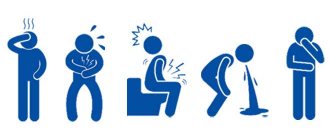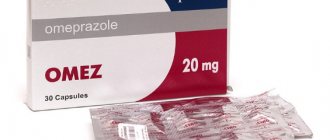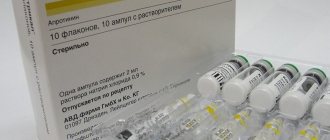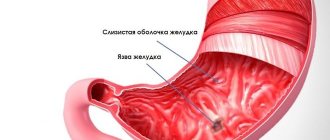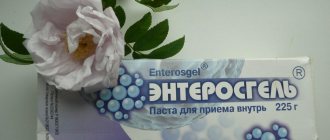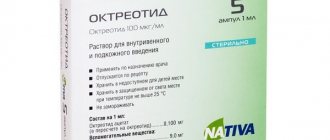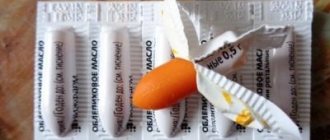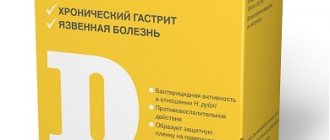Smecta is an effective medicine that perfectly helps against diarrhea of any origin. The drug binds and removes toxins, and also protects the mucous membranes of the digestive tract from damage. Thanks to this, Smecta gives a quick positive result for stomach pain. The sorbent is absolutely harmless and non-toxic, it does not cause side effects and has a minimum number of contraindications.
The main active ingredient of the medicine is dioctahedral smectite. It consists of magnesium and aluminum silicates that have undergone special processing. Once in the stomach, Smecta envelops the mucous membrane and protects it from the aggressive effects of dietary juice, which reduces the likelihood of exacerbation of peptic ulcers and bleeding. And, therefore, this allows you to relieve the feeling of nausea, heartburn and stomach pain that accompany disorders of the digestive system.
The second positive thing about taking Smecta is that it helps cure diarrhea. The absorbent properties of smectite allow it to absorb, bind and remove toxic substances and the remains of pathogenic bacteria.
Improvement in the patient's condition occurs quite quickly when taking Smecta.
Application
Smecta is used to treat the following symptoms that occur with various diseases of the stomach and intestines:
- acute and chronic diarrhea resulting from food and drug poisoning, as well as other pathologies;
- diarrhea due to the presence of intestinal infection;
- abdominal pain;
- heartburn, nausea and bloating, and other manifestations of gastritis.
Complete safety and lack of toxicity makes it possible to prescribe the drug Smecta for abdominal pain to babies from the moment of birth, pregnant women and nursing mothers. However, the medication must be taken strictly in a therapeutic dosage, otherwise it may cause difficulties with bowel movements.
Mode of application
The powder must be mixed with water (125 g of water per 1 sachet). The suspension (the resulting mixture) is prepared immediately before use. The fact is that otherwise the mixture reacts with oxygen, and it loses its medicinal properties and even causes irritation of the mucous membrane of the gastrointestinal tract (the patient begins to feel a burning sensation). The dosage of the medicine depends on the age and weight of the patient, as well as on the disease.
For acute, ongoing diarrhea, it is usually recommended to take 6 sachets of Smecta (for adult patients).
Standard dosages for diseases of the food tube:
- infants: no more than 1 sachet once a day;
- children aged 12 to 24 months: 1 sachet twice a day;
- children over 2 years old: 1 sachet twice or thrice a day;
- adults: 1 sachet three times a day.
As a rule, recovery occurs after 1 week of treatment, although sometimes 3 days are enough.
If a person takes the drug for more than 3 days, but does not feel better, this is a reason to contact a gastroenterologist or therapist. In addition, you need to visit a doctor before starting to take Smecta, especially if we are talking about infants.
Overdose
Exceeding the recommended dosage of the drug described most often leads to constipation. In this case, you need to stop treatment with Smecta to eliminate the problem.
Side effects
Side effects in patients taking the described enterosorbent were rare, but with allergies and exceeding the dose of enterosorbent in patients the following were noted:
- skin rashes;
- feeling of itching;
- Quincke's edema;
- nausea and vomiting;
- constipation
If, as a result of treatment with Smecta, a person feels unwell (any of the listed manifestations), you should immediately stop taking the suspension and inform your doctor.
special instructions
During treatment with Smecta, you should avoid drinking alcoholic beverages. Also, its effectiveness may decrease if a person combines it with other medications.
Pregnant and lactating women can take the drug without harming their own health and the health of the child.
Storage: terms and conditions
The permissible storage temperature of the medicine is +25 degrees Celsius. It is good for 36 months (3 years). Children should not have access to the home first aid kit, including the described powder.
Release from pharmacies
A doctor's prescription is not required when purchasing Smecta.
Price
A pack of Smecta of 10 sachets costs about 125 - 160 rubles. It is more profitable to buy Smecta for 30 sachets - a pack costs 350 - 400 rubles.
Analogs
It happens that Smecta is not suitable for a person due to individual intolerance or diarrhea was taken by surprise, and pharmacies do not have this remedy. In such situations, other sorbents can be used:
- Activated carbon. Black pills, well known to everyone. It is believed that this is an old generation sorbent, but it is produced today and sold in pharmacy chains. It remains attractive for its low price and high efficiency;
- Polysorb is an enterosorbent based on silicon dioxide;
- Enterosgel is a gel product sold in tubes and plastic jars;
- Carbopect, Ultra-Adsorb and Sorbex are black capsules. Modern version of Activated Carbon;
- Neosorb capsules are a sorbitol-based sorbent.
Analogs of Smecta for the active component - Neosmectin, Diosmectin. This is also the powder from which the suspension is prepared. Used in the same cases.
For diarrhea and other digestive tract disorders
Modern man, unlike his ancestors, even those who lived in the 19th century, tries to wash his hands before eating, as well as thoroughly rinse vegetables and fruits, but this does not always protect him from diarrhea or other problems with the digestive tract. As a result, you have to buy medications, for example, Smecta. After recovery or during treatment, some people share their experiences online. Medical sites are full of praise for the enterosorbent, saying that “Smecta for children is a really effective drug”, “it helps well with vomiting”, “a revolutionary remedy”, “a good adsorbent, removes toxins, poisons from the body, treats heartburn, colitis, acute and chronic diarrhea." Of course, there are also complaints about the medication, because it “does not work so quickly.” However, there are many more positive comments than negative ones. This means that the sorbent is suitable for most patients, but it is still better to consult a doctor first.
Contraindications
Before starting treatment for stomach pain and other manifestations of digestive pathologies with Smecta, it is very important to make sure that the patient does not have the following contraindications to the drug:
- hypersensitivity to the composition of the drug (to the main and additional components);
- the patient has a history of intestinal obstruction;
- individual intolerance to disaccharides and fructose;
- slow and difficult bowel movements (constipation);
- diseases associated with impaired absorption of simple carbohydrates.
Side effects
Despite the fact that Smecta is a completely safe and non-toxic drug, like any medicine, it can cause negative side effects. In very rare cases, smectite therapy can lead to the development of constipation. In order to avoid this effect, patients taking Smecta for stomach pain are advised to drink plenty of fluids throughout the day. If this problem does not go away, you should consult your doctor for advice.
Treatment with Smecta for stomach pain can also cause allergic symptoms that occur if the patient has hypersensitivity to the components of the drug. If itching, rash reactions, urticaria or other allergy effects occur, you must stop taking the drug and replace it with a similar medicine.
Mechanism of action of Smecta
The drug was developed specifically as a remedy for intestinal inflammation. Smecta for diarrhea is considered an effective medicine that removes any toxins and heals the mucous membrane of the stomach walls. The main active element is dioctahedral smectite. The substance contains silicon, magnesium and aluminum. Smecta retains fluid and also thickens stool, which relieves diarrhea.
It is worth noting that Smecta, unlike tablets, better envelops the mucous membrane, because the suspension is able to reach the most distant parts of the intestine. This allows us to call the drug effective against diarrhea of any origin. When it comes into contact with the mucous membrane of the esophagus, the drug increases its active layer, thereby relieving spasms and burning.
Dosage and method of use
To relieve stomach pain, cure diarrhea and get rid of other effects of disruption of the digestive system, you must strictly follow the dosage of Smecta prescribed by your doctor.
The medicine should be taken orally. For adult patients, the contents of one sachet should be diluted in half a glass of smoked water and drunk. For small children who have stomach pain, the absorbent agent is dissolved in baby food, preferably semi-liquid. For infants, the drug is mixed with mother's milk or a milk substitute.
Smecta should be taken between meals . The only exception is the treatment of esophagitis, in which case the absorbent substance is used after meals.
If a child has abdominal pain, Smecta should be taken as prescribed by a doctor, since first of all it is necessary to determine what is causing the stomach pain. If the pediatrician, during examination, excludes pathologies that require urgent intervention, then the medicine should be used according to the standard regimen.
Treatment of symptoms of various digestive pathologies, including stomach pain:
- for small children under one year of age, 1 sachet of Smecta is prescribed daily;
- a child from 1 to 2 years old should take 1 to 2 Smecta powders per day;
- patients over 2 years of age - 2 to 3 doses per day;
- adults take the medicine in the amount of 3 packets per day.
Smecta
Smecta is a modern antidiarrheal agent with an adsorbing effect.
Today, it is a first aid drug for stopping diarrhea of any etiology in children and adults, and it also reduces pain during diarrhea and other gastrointestinal disorders.
If indicated, it can even be used to treat infants, which is very valuable, since when children have diarrhea, there is not a very large selection of safe medications that help treat intestinal disorders.
The instructions for use of Smecta indicate that it is a natural enterosorbent, which promotes the fairly rapid removal of toxins, pathogenic bacteria, viruses, and harmful substances from the body.
Due to its natural origin, this remedy is very well tolerated by both small children and adults; its pleasant taste allows parents to treat even a small child without much difficulty.
In a therapeutic dosage, Smecta does not have a negative effect on intestinal motility.
The drug Smecta is available in the dosage form of a powder for the preparation of a suspension, which is taken orally (orally).
The powder has a white color with a grayish or yellowish tint and a slight vanilla odor. The main active ingredient of the drug is dioctahedral smectite, its content in one sachet is 3 g.
Smecta powder also contains auxiliary components, which include:
- Dextrose monohydrate.
- Vanillin.
- Sodium saccharinate.
Smecta powder is contained in laminated paper bags in the amount of 3.76 g. A cardboard pack contains 10 or 30 laminated paper bags with powder, as well as instructions for use of the drug.
Indications for use of Smecta
The drug is used for therapeutic purposes as an enterosorbent. Indications for use are the same for all ages, including infants from 4 months. According to the instructions, the indications are:
- peptic ulcer of the duodenum and stomach;
- gastritis;
- colitis;
- infectious diarrhea;
- flatulence;
- relief of heartburn;
- vomit;
- diarrhea, diarrhea;
- period of convalescence (recovery) after colonopathy;
- poisoning.
The unique medicinal properties of Smecta have been scientifically proven and confirmed by numerous studies. The drug is capable of removing up to 85% of pathogenic diarrhea pathogens from the human intestine.
In addition to its enterosorbing properties, Smecta has a positive effect, replenishing the necessary composition of sodium, potassium, and magnesium in the body.
An increase in the amount and density of mucus when taking Smecta has a beneficial effect on the walls of the stomach, protects against the negative effects of toxins and irritants.
Smecta for diarrhea
The medicine has established itself as an excellent remedy for diarrhea and diarrhea of medicinal and allergic origin, problems with diet and food quality.
The drug is prescribed for diarrhea, which is typical for the difficulties of travelers, for disorders due to infectious infections (depending on complex therapy).
When a diagnosis of irritable bowel syndrome is made, the remedy can bring significant relief to the patient due to the removal of gases and the absorption of excess irritating biomass.
When vomiting
The drug is acceptable and recommended for use for vomiting, when it is not a sign of severe pathology of the gastrointestinal tract.
If Smecta is used for an adult, then gastroenterologists recommend performing a gastric lavage procedure; such manipulation will help free the body from most of the toxic substances.
For childhood manifestations of vomiting, the drug is prescribed if the cause of the problem is food poisoning.
Smecta for poisoning
According to the instructions, Smecta is recommended if toxic toxic substances have entered the body through the stomach.
The active ingredient of the drug effectively expels toxins that have not been absorbed into the mucous membrane of the gastrointestinal tract.
The medication helps to establish the balance of intestinal microflora, creating a favorable environment for beneficial microorganisms. This substance reliably envelops the lining of the stomach, allowing epithelial cells to recover.
How does Smecta work?
Smecta is an antidiarrheal agent, aluminosilicate of natural origin (porous clay), which has a pronounced adsorbing effect.
This substance stabilizes the mucous barrier of the gastrointestinal tract, increases mucus, forming polyvalent bonds with mucus glycoproteins, reduces the negative effects of toxins, pathogenic microorganisms, bile salts, hydrogen ions of hydrochloric acid, since it binds toxic compounds and removes them with feces.
Since the active substance has a discoid-crystalline structure, it has a selective sorption property and adsorbs only bacteria, viruses, and toxins located in the lumen of the gastrointestinal tract, that is, it is not absorbed by the body, but leaves the intestine along with chemicals and harmful substances. When taking the drug in therapeutic doses, there is no negative effect on intestinal motility.
Dioctahedral smectite does not stain stool and is radiolucent. Even with diseases of the gastrointestinal tract, colitis and colonopathy, aluminum, which is part of smectite, is not absorbed from the intestines. The active substance of the drug is excreted unchanged and is not absorbed.
Contraindications
The drug contains organic sugars, so Smecta is not recommended for use in cases of fructose intolerance, sucrose-isomaltose deficiency, glucose-galactose malabsorption, or hypersensitivity to orange, vanilla, or caramel flavorings.
The drug is contraindicated in case of intestinal obstruction and severe constipation.
Instructions for use of Smecta: method and dosage
Smecta is intended for oral administration after meals (for esophagitis) or between meals (for other indications). The contents of the sachets are dissolved in water.
How to dilute Smecta for adults: the powder must be gradually poured into 100 ml of water (1/2 cup) and stirred evenly until a suspension is obtained.
Divide the prescribed daily dose into three doses throughout the day. Smecta for children must be diluted in a bottle (50 ml).
You can also mix the powder with one of the semi-liquid products (baby food, puree, porridge, compote). Divide the daily dose into several doses.
For acute diarrhea, the daily dose of the drug for adults is 6 sachets. Children under 1 year of age are prescribed 2 sachets per day for the first 3 days, then 1 sachet per day. In children over 1 year of age, use 4 sachets per day for the first 3 days, then 2 sachets per day.
For other indications, the daily dose of Smecta for children under 1 year is 1 sachet per day, for children 1–2 years old – 1–2 sachets per day, for children over 2 years old – 2–3 sachets per day, for adults – 3 sachets per day. day.
Duration of therapy is from 3 to 7 days.
How to use during pregnancy
Taking Smecta during pregnancy has no special contraindications.
Doctors prescribe Smecta to pregnant women in the second trimester to safely and effectively combat heartburn. The drug is also prescribed to effectively combat diarrhea. To prepare the medicine, take a glass of warm water and dissolve one sachet of Smecta in it.
The drug can be taken either once or as a course, depending on the severity of the situation. Usually the doctor prescribes taking Smecta three times a day. If you are taking any other medications, please note that Smecta should be taken 2 hours after taking them.
special instructions
Measures to rehydrate the body simultaneously with treatment with Smecta in adult patients are carried out as necessary. The choice of a set of measures to replenish fluid depends on the characteristics of the patient, his age and the course of the disease.
- For acute diarrhea in children, Smecta should be used in combination with rehydration measures.
- Other medications should be taken separately from Smecta, the interval between doses should be at least 1–2 hours.
- The drug does not affect the ability to operate machinery or drive vehicles.
Drug interactions
When used simultaneously, Smecta may reduce the rate and degree of absorption of other drugs. It is not recommended to take the drug simultaneously with other medications.
Side effects for the body
Smecta is given to children and adults in accordance with the instructions for use. It is well tolerated, but sometimes side effects may occur:
- constipation, diarrhea, nausea, vomiting;
- allergic reactions: urticaria, skin rash, itching, anaphylactic reactions, Quincke's edema, angioedema;
- dizziness, headaches;
- bloating;
- frequent bowel movements;
- digestive difficulties;
- darkening of tooth enamel;
- abdominal pain, feeling of heaviness in the stomach.
According to the instructions, side effects go away quickly and do not require drug discontinuation or symptomatic therapy.
Overdose
It is not recommended to take Smecta on your own, since any disease requires consultation with a doctor. When prescribing Smecta to children, it is important for a pediatrician to take into account the child’s age, possible allergic reactions, and contraindications for use.
Children should be given Smecta strictly according to the instructions, having first received a prescription from a pediatrician.
Reviews of people who took Smecta
Smecta is an original medicine containing a naturally occurring substance, diosmectite, as an active substance. The latter, being a silicate of Mg and Al, differs favorably from other silicon compounds in its structure and properties.
The diosmectite molecule has a stereometric configuration and is characterized by increased plastic viscosity, due to which the drug not only effectively adsorbs harmful substances, but also has a protective effect on the mucous membrane of the digestive tube.
Most of the reviews are reviews of Smecta for children, and, in particular, for infants and newborns. Acting quickly and gently, the drug relieves symptoms of poisoning, relieves heartburn, and eliminates infectious digestive problems. Therefore, according to most mothers, in families with children, it must be in first aid kits.
The main advantages of Smecta are:
- “children’s” dosage form and pleasant taste;
- the ability to significantly reduce the duration of the disease and, accordingly, the costs of treatment (this fact is confirmed by numerous studies and, in particular, studies conducted by SIGEP specialists);
- good tolerance;
- few restrictions on use.
To date, there is encouraging data on the effectiveness of the drug in the treatment of gastroesophageal reflux in children in the first 4 weeks of newborn life, as well as on its use for prophylactic purposes to prevent the development of chronic diarrhea during radiation therapy in patients with cancer .
Does Smecta have analogues?
Analogues of the drug are:
- “Neosmectin” is essentially another trade name for “Smecta”;
- Activated carbon - both traditional black and “white”, which is the same silicon dioxide plus auxiliary components;
- “Enerosgel” is a Ukrainian-made drug with methyl silicic acid as a base;
- “Enterodez” is a Russian powder product for preparing suspensions, the active ingredient of which is povidone (polyvinylpyrrolidone, a synthetic indigestible polymer);
- “Polysorb” is a powder analogue of “White Coal”, since it also contains silicon dioxide.
A number of Smecta substitutes, despite their lower cost, have their own advantages. For example, Enterodes (povidone), with the same good astringent properties, does not contain aluminum salts (they are harmful to bones and there are suspicions of their toxicity to the fetus during pregnancy). At the same time, unlike Smecta, it stimulates kidney function, which can be dangerous in case of nephritis, hypotension, and dehydration.
Both Smecta and activated carbon are preparations with sorption properties.
However, Smecta has a number of advantages in comparison with the latter. Firstly, this drug is distinguished by its selectivity of action: it removes toxic substances, hydrochloric acid, excess bile acids and viruses, but does not take the substances it needs from the body.
Activated carbon, along with pathogenic microorganisms and poisons of biological origin, also removes beneficial bacteria, without which the stomach and intestines subsequently cannot function normally. Diosmectite helps create the most optimal conditions in the body for the development of beneficial microflora.
Secondly, acting very gently, the drug envelops the walls of the digestive canal, protecting them from aggressive factors, while activated carbon, which has a rigid structure, can further injure them.
The cost of Smecta currently in pharmacies in Russian cities varies within the following limits:
- Powder 3 g, 10 sachets – 125 – 190 rubles;
- Powder 3 g, 30 sachets – 330 – 447 rubles.
There is no difference in the cost of Smecta depending on the flavor (vanilla or orange). However, some pharmacies, guided by their own pricing policies, may charge different prices for the same packages of Smecta with vanilla and orange flavors.
Storage conditions and periods
The drug should be stored out of the reach of children at a temperature not exceeding 25°C. Shelf life – 3 years.
Features of use
Before you start taking Smecta for abdominal pain, it is very important to find out the cause of this symptom and localize the area of pain. Since discomfort in the stomach area can cause pathologies that require immediate surgical intervention.
If your stomach hurts along with fever, vomiting or other negative symptoms, you should consult a doctor for immediate advice.
In order to avoid constipation during treatment, patients of all age groups should drink as much fluid as possible.
Complex therapy with other drugs is carried out according to a special scheme. At least two hours should pass between taking Smecta and other medications. Such a break is necessary because smectite can significantly reduce the absorption of drugs in the intestines and stomach.
If side effects develop, you must stop taking Smecta and consult your doctor. To continue treating the stomach pain, he will prescribe the patient a substitute medication.
How to take for gastritis
Smecta is most often prescribed for gastritis with high acidity, since this drug provides additional protection for the mucous membrane, due to which pain and other unpleasant symptoms of the disease disappear soon after administration.
Smecta is also suitable for patients with gastritis with low acidity, since taking the product stimulates the production of protective mucus on the walls of the stomach.
Advice! As a rule, for stomach diseases, Smecta is prescribed in combination with other drugs, since treatment requires the use of a number of medications for a complex effect.
It is recommended to take the product three times a day, an hour before the planned time of breakfast, lunch and dinner. But if gastritis occurs simultaneously with reflux esophagitis, then the suspension must be taken immediately after meals.
Before taking Smecta, the powder must be diluted in water. Take 100 ml of water and stir the powder in it. The powder does not dissolve in water, but turns into a suspension, that is, a solution in which solid particles are suspended. When settling, the solid phase will settle at the bottom, so you need to drink the suspension immediately after preparation, without waiting for a precipitate to form.
Advice! If the medicine is being prepared for a child, then the powder should be diluted in 50 ml of water. Instead of water, you can use milk or other drinks your child is familiar with. If the baby does not like the taste of Smecta, then it can be replaced with Neosmectin, as it has a milder taste.
The course of treatment is 3-7 days, specific terms of admission are discussed individually with a gastroenterologist. You can use Smecta once if your diet has been disrupted and abdominal pain appears.
If the drug is prescribed in combination with other drugs, then it must be taken into account that the interval between doses of enterosorbent and other drugs should be at least 60 minutes.
Smecta for pancreatitis
Published: October 15, 2014 at 10:28 am
Smecta is a medicinal product of natural origin, produced in powder form, which has an adsorbing pharmacological effect and is used:
- for chronic and acute diarrhea of medicinal, allergic, bacterial and infectious origin, in case of poor nutrition and quality of food consumed;
- treatment of symptoms of flatulence, heartburn, belching, abdominal discomfort due to gastritis, colitis, stomach ulcers, pancreatitis.
Smecta has no contraindications and is approved for use by pregnant women and young children. Constipation is one of the commonly observed side effects of this absorbent powder, which can absorb toxins, gases, and pathogenic bacteria.
In patients suffering from chronic pancreatitis, indigestion accompanied by pancreatogenic diarrhea is quite common. This is explained by the fact that the inflammatory process, disrupting the exocrine function of the pancreas, slows down the digestion process due to enzyme deficiency. Incompletely digested food, remaining in the stomach for a long time, is attacked by bacteria, which causes putrefactive and fermentation processes, causing diarrhea and flatulence. Therefore, in the complex treatment of pancreatitis, doctors often prescribe smecta as a drug that can neutralize pathogenic processes in the gastrointestinal tract, thereby eliminating unpleasant symptoms and normalizing the patient’s stool.
Composition and effect of the powder
For mild intoxication of the body, adult patients drink 2 sachets per day, for severe poisoning - up to 6 sachets over 24 hours.
Smecta is a sorbent that instantly eliminates toxic elements from the intestines, thanks to its composition:
- The active substance is dioctahedral smectite.
- Vanilla and orange flavors.
- Artificial sugar substitute.
- Glucose.
Produced in powder, 3.76 g in 1 sachet. Diosmectite is a porous clay, acting on the body as a powerful adsorbent.
The drug works as follows:
- activates mucus production,
- absorbs viruses, pathogenic microorganisms in the gastrointestinal tract,
- helps increase immunity in the intestines,
- stabilizes the mucous membrane of the digestive tract,
- reacts with mucus
- does not affect intestinal motility.
The drug does not stain feces, aluminum is not absorbed from the gastrointestinal tract.
How to get rid of heaviness in the stomach
Properly selected medications will help eliminate ailments and symptoms of many diseases. If you are thinking about how to get rid of heaviness in the stomach, then a doctor should answer this question. Before prescribing the pills, the specialist will conduct an examination and, if necessary, prescribe an examination to establish the causes of poor health. This will determine the methods that should be used for therapy.
How to eliminate the feeling of heaviness in the stomach?
When treating, doctors can use complex techniques consisting of the use of various therapeutic methods (for example, traditional medicines, medications, dietary nutrition). It all depends on what caused the pain and discomfort.
Which pills to choose for heaviness in the stomach?
- "Festal". Indicated for use in cases of permanent and one-time dysfunction of the digestive system. "Festal" speeds up digestion. Doctors recommend taking it to people who suffer from constipation and flatulence. Analogues of “Festal” are “Mezim”, “Penzital”, etc.
- "Smecta". The medicinal powder helps with pain that occurs in young children and adults. In addition, it is used for diarrhea.
- "Motonium". Allows you to activate the work of the stomach and duodenum. At the same time, Motonium does not affect the formation of secretions in the gastrointestinal tract. Motilium is considered an analogue of the drug, but it should not be taken without a doctor’s prescription. Such tablets should not be prescribed to children who weigh less than 35 kilograms. They have an antiemetic effect.
- Ranitidine affects gastric juice, reducing its secretion. Ranitidine should be taken for diseases caused by high acidity of gastric secretion. The tablets relieve the symptoms of gastrointestinal dyspepsia. The action of Omeprazole is similar to that of Ranitidine, only the former is available in capsule form. Ranitidine has no contraindications, and Omeprazole is prohibited from being prescribed to children and women who are expecting a child and are breastfeeding.
Is it possible to take smecta for pancreatitis instructions for use.
In the presence of an inflammatory process in the pancreas, which occurs with atrophy of this organ, doctors diagnose a person with chronic pancreatitis. This disease is classified as a serious disease and requires treatment in a hospital.
Symptoms and causes of pancreatitis
Chronic pancreatitis has many unpleasant symptoms, such as:
- Decreased appetite.
- Pain syndrome of shingles nature.
- The person is constantly sick.
- There is belching.
- Bowel dysfunction (irritable bowel syndrome).
- Dysbacteriosis and flatulence are observed.
- Periodic bloating.
- Loss of body weight.
- Night vision is weakened due to poor absorption of vitamin A.
Scientists are sounding the alarm. Every year the number of patients diagnosed with pancreatitis grows exponentially. And this despite all the efforts of doctors to implement preventive measures.
The first place among the reasons that cause this pathology is malnutrition (fast food). And although everyone knows about its negative impact on the human body, no one can deny themselves this until their health completely deteriorates.
The main causes of the disease include the following factors:
- alcohol abuse;
- intoxication of the body;
- irregular food intake;
- pathology of the endocrine glands;
- atherosclerosis of pancreatic vessels;
- presence in the diet of large quantities of fatty and spicy foods;
- long-term use of various medications (paracetamol, contraceptives, steroid hormones);
- poisoning by various chemicals;
- frequent occurrence of stressful situations;
- gallbladder diseases;
- infectious pathologies of other human organs;
- the presence of a parasitic infection.
Medical nutrition
In the acute form of pancreatitis, treatment at home can end tragically, which is why at the first symptoms of the disease the patient is urgently hospitalized in a hospital. For the first time, the patient is shown fasting. After a few days, the patient can eat little by little.
Diet is the most important stage in the treatment of acute and chronic pancreatitis, and it should be followed not only in the hospital, but also at home after discharge, otherwise a new exacerbation cannot be avoided.
Doctors recommend that such patients follow the following nutritional principles:
- Food should be taken baked or boiled, or stewed. The patient's nutrition is fractional. Food is taken in small portions, up to 8 times a day.
- Food should be liquid, semi-liquid and pureed in consistency. In case of stable remission, you don’t have to chop the food.
- You should not eat foods that contain large amounts of wheat (wheat porridge, wheat bread).
- Some fruits that contain a lot of fiber may slow down recovery (pears, peaches, nectarines, plums, citrus fruits, red and yellow apples).
- You should not eat foods that have a stimulating effect on the secretion of the pancreas - rich broths from meat and fish, fatty meat and fish, lard, smoked, fried and spicy foods. Also prohibited are any chocolate, hot spices and seasonings, fresh baked goods and bread, pickles, marinades.
- Products that cause fermentation are also not recommended.
- To quickly restore the functioning of the pancreas, you should introduce a sufficient amount of protein into your diet on a daily basis (chicken eggs, dietary meat and fish, dairy products).
- Animal fats should be replaced with vegetable oils.
- You should limit your intake of alcohol, strong tea and coffee, cocoa, sour fruit juices, and kvass.
- The amount of carbohydrates will have to be reduced (sugar, jam, honey), since pancreatitis often affects the parts of the pancreas that are responsible for the production of insulin. This will help prevent diabetes, allergic reactions, and nervous disorders.
Indications for use
In accordance with the instructions, the main indications for the use of Smecta for abdominal pain are:
- Acute and chronic diarrhea syndrome;
- Nausea and vomiting of any origin;
- Acute intestinal infections;
- Pain syndrome with esophagitis, gastric and duodenal ulcers, protracted diseases of the colon, and so on.
As an adsorbent drug, Smecta is widely used in the treatment of food poisoning and any intoxication.
Analogs
Drugs with similar properties may have different or similar compositions.
"Diosmectit" and "Neosmectin" are drugs completely similar to "Smecta". Their composition and properties are completely similar.
Enterosgel is a medicine that contains methyl silicic acid hydrogel. The medication perfectly removes toxins, facilitates the functioning of the liver and alleviates the course of skin diseases. The drug is approved during pregnancy, including to relieve symptoms of toxicosis.
We recommend: How to take Imodium for diarrhea?
Activated carbon is taken for food poisoning. The dosage is calculated based on body weight - 1 tablet per 10 kg of weight. The medicine is made from charcoal. Allowed for use by pregnant women. It is important to remember that this remedy removes beneficial substances from the body in large volumes, although it is not very effective in terms of removing toxins.
"Atoxil" is used for all forms of food poisoning. It quickly relieves symptoms of intoxication, including nausea, vomiting and diarrhea. The medication binds toxic compounds and removes them out.
Side effects and contraindications
Since the drug is not absorbed in the digestive tract, it has no systemic effects.
In fact, the only side effect when taking Smecta is temporary constipation, which goes away on its own after stopping the medication. Due to this undesirable effect, the drug is contraindicated in patients with intestinal obstruction, tumor diseases of the colon, as well as with individual intolerance.
It is allowed and even recommended to use Smecta for abdominal pain in a child. The drug is approved for children of any age, but during therapy the instructions for use should be strictly followed.
You also need to remember that infants taking Smecta increase the risk of intestinal colic and constipation.
Since the drug has a powerful adsorbing effect, it is not recommended to take it together with other medications - due to their combined use, the effectiveness of other medications will decrease.
Features of use during pregnancy
During pregnancy, many women experience the phenomenon of intestinal upset. Sometimes this occurs against the background of hormonal changes, and sometimes it is provoked by errors in nutrition. The use of “Smecta” during pregnancy is permitted, since the drug is not absorbed in the intestines and does not enter the bloodstream.
We recommend: How to take Regidron for adults and children with diarrhea?
For the same reason, it is allowed during feeding. For newborns, the use of Smecta does not cause any negative effects, since the drug does not pass into mother’s milk.
